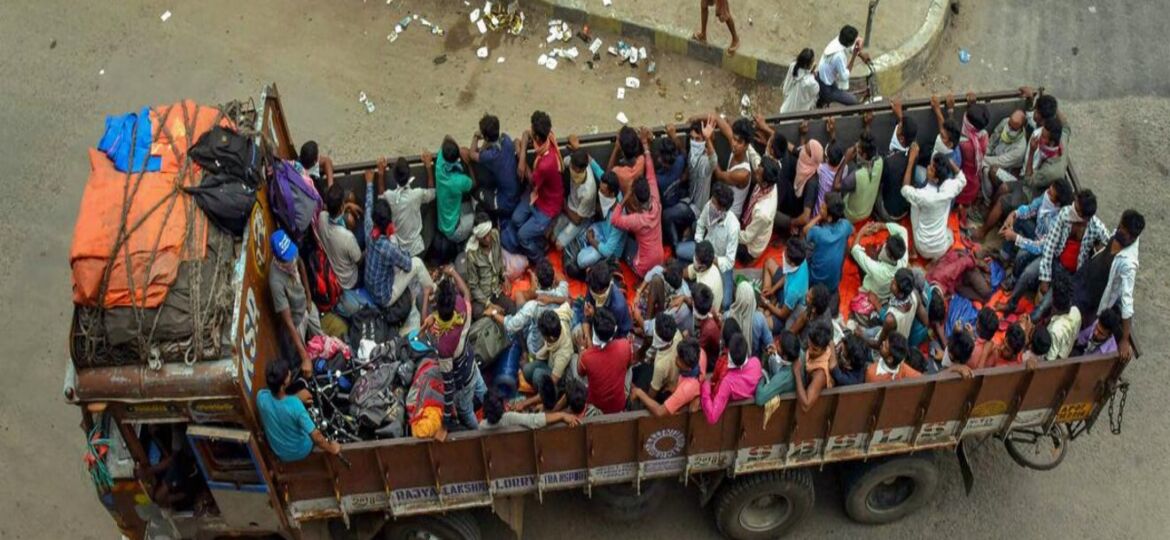
INTRODUCTION
We cannot easily forget the heartbreaking images of the exodus of migrant workers in the aftermath of the March Covid 19 lockdown. Labour migrants in the cities who had lost their employment, wages, and homes had little option but to return to their homelands, and they were determined to walk for miles in the sweltering heat as transportation was suspended as part of the lockdown. Today, after a year of harrowing exodus across India, the situation is no better for them, as the second wave of Covid 19 has prompted lockdown in many parts of the country. But the crucial question is whether any steps have been taken to secure unorganized and migrant workers in the long run. Although the country is dealing with a slew of issues related to the Covid 19 boom, India has little time to talk about migrants. The plight of migrants is not a source of concern for policymakers. There is no accurate estimate of the number of migrants who have returned to their homelands, and no safeguards have been put in place to protect returning migrants. The only sop center has come up with is the Garib Kalyan Rojgar Abhiyan (GKRA), which aims to create livelihood opportunities for returned migrant workers and applies to 116 districts, while important migrant-populated states such as West Bengal and Chhattisgarh are exempted.
As per the 2018-19 Economic Survey, 93 per cent of the total workforce is working in the “informal” sector. According to the 2011 census, internal migrants cover 45.36 crore people in India. This applies to both interstate and intrastate migrants. We expect 600 million internal migrants in 2020 based on census patterns. The Economic Survey 2016–17 estimated an inter-state migrant population of 60 million and an inter-district migrant population of 80 million (Government of India 2017).
LEGISLATIVE CHANGES
The major legislative changes in 2020 concerning the workforce are the enactment of three new labour Codes-the Industrial Relations Code (IRC), the Occupational Safety and Health and Working Conditions Code (OSHWCC), and the Social Security Code (SSC). These codes, including the Code on Wages passed in 2019, subsume 29 existing laws on labour. With these changes in legislation, the important question concerning migrant workers is whether these new codes are a one-stop solution for the betterment of the vulnerable groups?
The Inter-State Migrant Workers (Regulation of Employment and Conditions of Service) Act of 1979 was the most relevant legislation in place to protect migrants, and now it has been subsumed into the Occupational Safety, Health, and Working Conditions Act. (OSHWCC)
Consolidation and simplification of Labour laws was the proposed recommendation of the National Commission on Labour (2002). These Codes aim to bring uniformity in labour laws and to promote ease of doing business, thereby increasing Foreign Direct Investment flows.
Occupational Safety, Health, and Working Conditions Act
OSHWCC is one of four codes that encompass 13 labour laws governing worker health, safety, and working conditions. The Codes benefited the working class by establishing a universal minimum wage, trade union recognition, social security for gig and platform jobs, and a broader definition of migrant workers, among other things. However, a closer examination reveals that the code falls short of ensuring the safety and health of all employees.
The major concerns around OSHWCC are:
- The Code fails to address concerns related to the safety and working conditions of most workers in the informal sector, like the agricultural sector, which employs more than 50% of the total working population of India.
- The bill provides special provisions along with general provisions for all establishments like filing returns, duties of employers, etc. But the mandate for providing special provisions is unclear and special categories of workers like migrant workers are not allotted any specific provisions.
- When the number of intrastate migrants in India is large in number as per the 2011 census, the code fails to address it. Intra-state migrants have been entirely excluded from the Code’s scope, despite being subject to exclusion and alienation in urban labor markets based on class and ethnicity.
- There is a wide delegation in respect of safety standards. The code has not even mentioned minimum Occupational Safety and Health Standards. These are delegated to the Central Government to notify accordingly. This is a disheartening provision as it causes concerns about its implementation.
- Although the OSHWC Code incorporates the Contract Labour (Regulation and Abolition) Act of 1970 and the Inter-State Migrant Workmen (Regulation of Employment and Conditions of Service) Act of 1979, it excludes the Bonded Labour Act, potentially leaving a gap in the law. (said Dr Avinash Kumar, Associate Professor at Jawaharlal Nehru University’s Centre for Informal Sector and Labour Studies)
SOCIAL SECURITY CODE (SSC)
The SSC, 2020 has amalgamated nine existing labour codes like the Maternity Benefit Act, 1961, Employee Compensation Act, 1923, etc to consolidate social security laws for all employees working in organised and unorganised sectors and to ensure uniformity.
The National Commission (2002) put forward some important and inclusive recommendations like social security applicability to every establishment, removal of wage ceilings, etc. But the 2020 Code fails to incorporate these recommendations. After the 2019 Bill, the Standing Committee has also recommended changes, but the code largely retains the current setup.
Issues are:
- Instead of providing universal social security to all workers, the code has established specific categories for obtaining social security, which may result in the exclusion of a large portion of the labour force from its protection. For instance, a pay limit is retained in Section 2 (82) to describe a waged worker. However, such ceilings could be set arbitrarily, and the Code maintains this provision notwithstanding the Standing Committee’s suggestion that it be removed.
- The Code distinguishes between those who work in organized and unorganized industries. S. 2 (85) provides that an unorganized sector enterprise is one with fewer than 10 workers. According to the sixth Economic Census in 2013-2014, only 30% of India’s workforce is in establishments with six or more workers. This will result in the exclusion of a large portion of the workforce from receiving social security benefits.
- The most disappointing distinction is between rights and benefits. That is, rights like Provident Fund, gratuity, Employees’ State Insurance, and maternity benefits are accessible to organised sector workers. Chapter IX of the 2020 Code contains provisions for informal workers, gig workers, and platform workers which are grossly inadequate. That is, as per sections 109 and 110, the Central Government and State Government can make schemes for the protection of the unorganized sector. This is not a right granted, but rather a benefit granted at the discretion of the executive. The Parliamentary Committee recommended that minimum entitlements be extended uniformly to all workers for social protection. But these recommendations were not added to the Code.
- Contractors were expected to pay a displacement allowance to interstate migrant workers at the time of their recruitment, independent of the number of migrant workers onsite under the 2019 Bill, which was equal to 50% of their monthly salaries. This clause is removed from the 2020 Bill.
- As per S. 113 of the Code, every unorganised worker, gig worker, or platform worker must be registered. One of the important reasons why the government couldn’t give a helping hand during the exodus of migrant workers last year is due to the unavailability of information about their numbers and state of origin. Therefore, registration of inter-state migrants may seem helpful, but, as per the provisions, the migrant workers are to be registered themselves through the state government or using Aadhaar and telephone authentification. This assumption of all the migrants having Aadhaar and smartphones can be bad. So these unclear provisions could lead to a crack in the implementation as the earlier laws also contained provisions requiring registration.
- Many observers have noted that the distinction between ‘gig workers’ and ‘platform workers,’ as well as how these groups overlap with other unorganized job classes, is unclear. The Parliamentary Standing Committee has rightly pointed out in its recommendations to provide clarity in this regard, but the Code still sustains the confusion.
Several core elements of the codes are left to rule-making, such as the applicability of social insurance policies and health and safety regulations. The question is whether the legislature should decide these issues or whether they should be delegated to the executive. The Standing Committee on Labour noted that the 2019 Social Security Bill delegated various aspects to rule-making by the government, particularly with defining the entitlements, benefits, and contributions under the Bill. It was proposed that the Ministry go through all of the delegation clauses in the Bill again. This recommendation was ignored in the 2020 Codes.
CONCLUSION
Migrant workers face a grim future today as a pandemic affects their livelihoods. The major concern which exists even in this crucial situation is inaction from the governments to implement the existing labour laws. The hastily enacted labour laws have yet to be implemented. The central government set April 1, 2021, as the deadline for implementing all four codes simultaneously. However, several state governments have yet to draft the Codes’ laws, causing a delay in implementation. This has now resulted in a “legal vacuum,” which has many negative consequences for both enterprises and workers. It is imperative to take action to implement the labour laws which now merely exist on paper to withstand the grimmer phase of the economy.
Author(s) Name: Helna George (Mahatma Gandhi University, Kerala)
References:
















